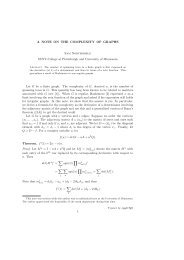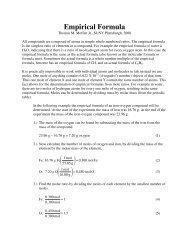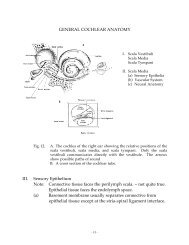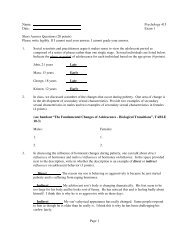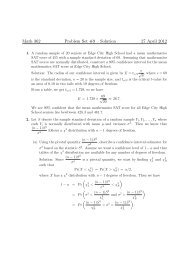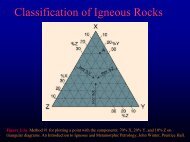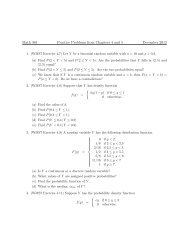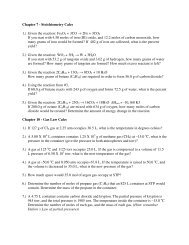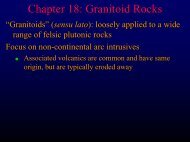Math 361 Problem Set #5 Due 5 October 2012 - Faculty web pages
Math 361 Problem Set #5 Due 5 October 2012 - Faculty web pages
Math 361 Problem Set #5 Due 5 October 2012 - Faculty web pages
Create successful ePaper yourself
Turn your PDF publications into a flip-book with our unique Google optimized e-Paper software.
<strong>Math</strong> <strong>361</strong> <strong>Problem</strong> <strong>Set</strong> <strong>#5</strong> <strong>Due</strong> 5 <strong>October</strong> <strong>2012</strong>Instructions: Write your solutions in complete sentences.presentation as well as mathematical correctness.Solutions will be graded for1. In calculus, we learn the formula for the sum of a geometric series:∞∑r k =k=011 − r(1)for |r| < 1. Find a closed-form expression for(1) and then multiplying through by r.∞∑kr k by differentiating both sides ofk=02. (Based on WSM7 Exercise 3.10) A rental agency that leases equipment by the day hasfound that one particular tool is leased, on average, only one day in five. Assume thatrental of the tool on any one day is independent of its rental on any other day.An experiment begins when the tool is returned from a rental, and consists of classifyingeach succeeding day as either n (no rental) or r (rental) until the first r occurs.(a) Describe the sample space for this experiment.(b) Let Y be the number of non-rental days before the tool is rented again. Find theprobability distribution for Y .(c) If the tool has just been returned, find the probability that there will be at leastthree non-rental days before the next rental.(d) Find the expected value of Y . (HINT: Use the result from problem 1.)3. (Based on WMS7 Exercise 3.11) Among the large number of donors who come to acertain blood bank, the proportion who have type O+ blood is p 1 , and the proportionwho have type O− blood is p 2 . Let q = 1 − p 1 − p 2 . Then q is the proportion of thedonors who do not have group O blood.An experiment consists of randomly selecting three donors who come to this bloodbank, and observing their blood types.(a) Describe the sample space for the experiment. The questions will all be aboutgroup-O donors (positive and negative), so you can lump all the non-group-Odonors together.
Let X be the number of O+ donors among those selected. Let Y be the number ofO− donors among those selected.(b) List the outcomes in X −1 (k) for k = 0, 1, 2, 3. Use this to construct a probabilitydistribution for X. The probabilities in your probability distribution will be interms of p 1 , p 2 , and q.(c) Construct a probability distribution for Y . Again, your probabilities will be interms of p 1 , p 2 , and q.(d) Let Z = X + Y , a random variable counting the total number of group-O blooddonors among the three selected. Construct a probability distribution for Z.Note: You can check your work against the answers given in the back of the textbookby plugging in p 1 = 1/3 and p 2 = 1/15. There’s (at least) one mistake in the answergiven in the seventh edition.4. (Based on WMS7 Exercise 3.14) The maximum patent life for a new drug is 17 years.Subtracting the length of time required by the FDA for testing and approval of thedrug provides the actual patent life for the drug—that is, the length of time that thecompany has to recover research and development costs and to make a profit. Theprobability distribution for Y , the actual patent life of a new drug, is given below:y (years) 3 4 5 6 7 8 9 10 11 12 13P (Y = y) 0.03 0.05 0.07 0.10 0.14 0.20 0.18 0.12 0.07 0.03 0.01(a) Find the mean patent life for a new drug.(b) Find the standard deviation of Y .(c) What is the probability that Y lies within one standard deviation of its mean?Within two standard deviations of its mean?5. (Based on WMS7 Exercise 3.28) A set of five components includes two that are defective.A technician puts the components in a random order and then tests them, one ata time, until both defective components are found. She then tests the second defectivecomponent again, to ensure accuracy.(a) The random element in this problem is the order in which the defective and nondefectivecomponents are selected. We can represent each outcome as a string oftwo d’s and three n’s.List the elements of the sample space. Assuming they are all equally likely, whatis the probability of observing any particular outcome?(b) Let Y be the total number of tests that the technician performs. Construct aprobability distribution for Y .(c) If the cost of each test is $2 and the cost to repair a defective component is $4,find the expected total cost of testing and repairing the whole set of components.



